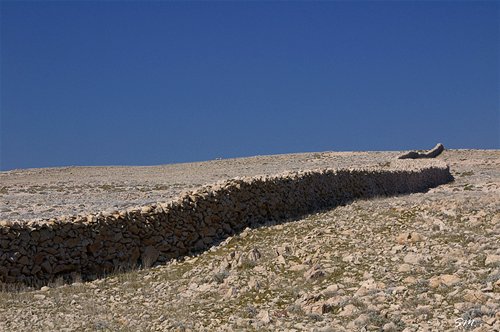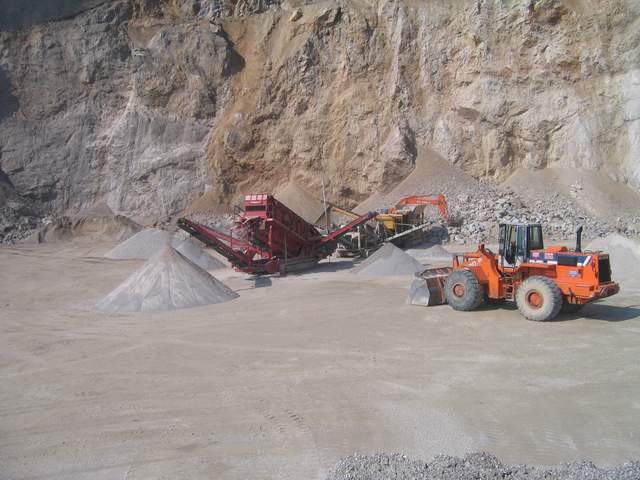Croatia, country made of stone!
 •
by
•
by conrexx
Among others, stone is a new resource which will be implemented in Erepublik, finally something that we have more than enough.
Croatian Limestone has a long history, dating back to Roman times. The remains of old Roman quarries can be found along the coast. One of the most important amphitheatres can be still be seen in the town of Pula. It was built in the 1st century AD using stone from a nearby quarry.
The town of Split was built in the 4th Century BC using limestone from the island of Brac. The Basilica of Eufrasiana in Istria was built of marble and other stone imported from Greece and Bosnia. So there is strong evidence that there was an international stone trade already in operation as far back as the 5th/6th centuries.
Stari Grad, still intact, is a perfect example of old Croatian architecture, with its paved squares and fountains, steep cobbled streets palaces, steepled churches were all made from the distinctive light coloured limestone which characterised the country's architectural history.
Stone has been used in some of Croatia's most important historic buildings; from the Renaissance and Baroque periods right up to the present day. Not only has the stone found uses locally but also abroad.
Not many people are aware that the white limestone columns of the White House in Washington DC came from Croatia. Even today, many important buildings throughout the world have utilised Croatian Limestone, from the Parliament and New Palace in Vienna Austria to the sculptures in Battery Park New York. "Orsera", a very hard and dense limestone, ivory in colour, has been used in many of Venice's restoration projects, thanks to its suitability for buildings in continuous contact with water.
On Adriatic coast, stone was much more the problem than advantage. Our ancestors had to remove stone from fields, so that they can turn them into ploughland and to be able to cultivate those fields. Simply, all the fields were covered in stone and only way to reach the soil was to remove that stone. Here you can see with what they have to deal with:

As consequence today we have numerous stone walls all a long Adriatc coast and islands. Today this dry stone walls are a tourist attraction but in those days it was a need. Bellow you can see for yourselves how it looks like:
[img]http://3.bp.blogspot.com/_SzunzvqayoE/RpPIy46mt0I/AAAAAAAABsI/F3WbLoOUh3c/s400/croatia+hvar+stone+walls.JPG[/img]





People in Istria went even further and inhabitants of that peninsula built small storage house from stone in the middle of ploughlands



Stone as a very useful material was recognized by Admins only now, but we use it for centuries:



and also in modern architecture:



And it is also worth to mention that all town cores along Adriatic coast and islands are made of, guess what, stone:





And here are some photos of exploiting stone


[img]http://regionalexpress.hr/images/uploads/kamenolom.JPG[/img]

And thanks to dr. Boza Chaos, we made a job for Admins a lot easier, with one click on the map you can see which regions are full of stone

We are not demanding we are only stating the obvious!
So, when we are talking about stone, eCroatia should be one of the richest countries in Erepublik!
Please sign this open letter!
http://tinyurl.com/ybz3lxv


Comments
vote & sub
We need that stone
Vote
vote
we have more then inof of it
vote & sub
We need that stone
vote & sub
If we don't get it - I'll throw stones at ya!
ВОТЕ БРЕ
vote
voted
White house is made from our stone
ma nis od toga,pogledaj RL liku pa su je stavili medium,nebi se cudil da bude i sad Lika medium stone 😒
Daj boze da nam daju ono sto je nase,al sumljam.
Vote
you could put high titanium to 🙂
v + s
my RL house is made of stone too 😃
White house in Washington is made from Brac stone....
Give us stone please! Brac stone is one of the best in world!
White house is made from our stone, from Brac stone!
vote & sub
We need that stone
we deserve high STONE!!!
Kazuni yeah 😉
RL White house is made from Croatian stone! (inače, to sam ja odma rekao čim sam vidio stone, ima da bude dalmacija High 😉 )
Vote!
Ali sve se bojim da administratori opet neće nešto zgučkati i dati nam medium umjesto high regiju 🙁
istina je, bijela kuca je napravljena od brackog kamena!
mogo si staviti neke kamenolome u dalmaciji -.-
a ne kuce i tak to
inace voted
http://www.marbleandmore.com/en/Countries-and-Market/The-Croatian-Stone-Industry/news.htm?n=455" target="_blank">http://www.marbleandmore.com/en/Countrie[..]n=455
Mogli bi peticiju na eR forumu. Bolje sad gnjaviti dok nije prekasno. Barem da im stavimo bubu u uho da slucajno ne misle staviti neki medium..
Ajde conrexx c/p clanak tamo pod Open Letters 🙂
vote
pa radi brača bar da nam daju jebote
vote
vote
BRAVO!
HIGH regija nama, ostalima nista!
vote & sub
We need that stone
vote!
Brac stone
Traditional using of Brac stone is being conducted with advanced tehnology. While in 1950's was being produces about 5000 m³ stone blocks, production has raised to 17000 m³ stone blocks and over 300 000 m² sawed stone boards. Brac stone has became famous in the world because of his quality.
BOTE
vote
Stone for Stones
Joke 😃
vote!
croatia need that stone
vote & signed
signed
vote i shout!
a ako je zocky stavio signed onda idem i ja 🙂
VOTE RATRAK
vote
Bravo conrexx 😁
v+s shout
dodaj dubrovačke zidine.....i šibensku katedralu....prelijepe stvari od kamena 🙂
signed
V. Sub otprije. Predivne fotke suhozida. 🙂
vote
vote
Samo gdje je Zlovenija pokušao ju naći,ali nigdje :/....😃
vote 😃